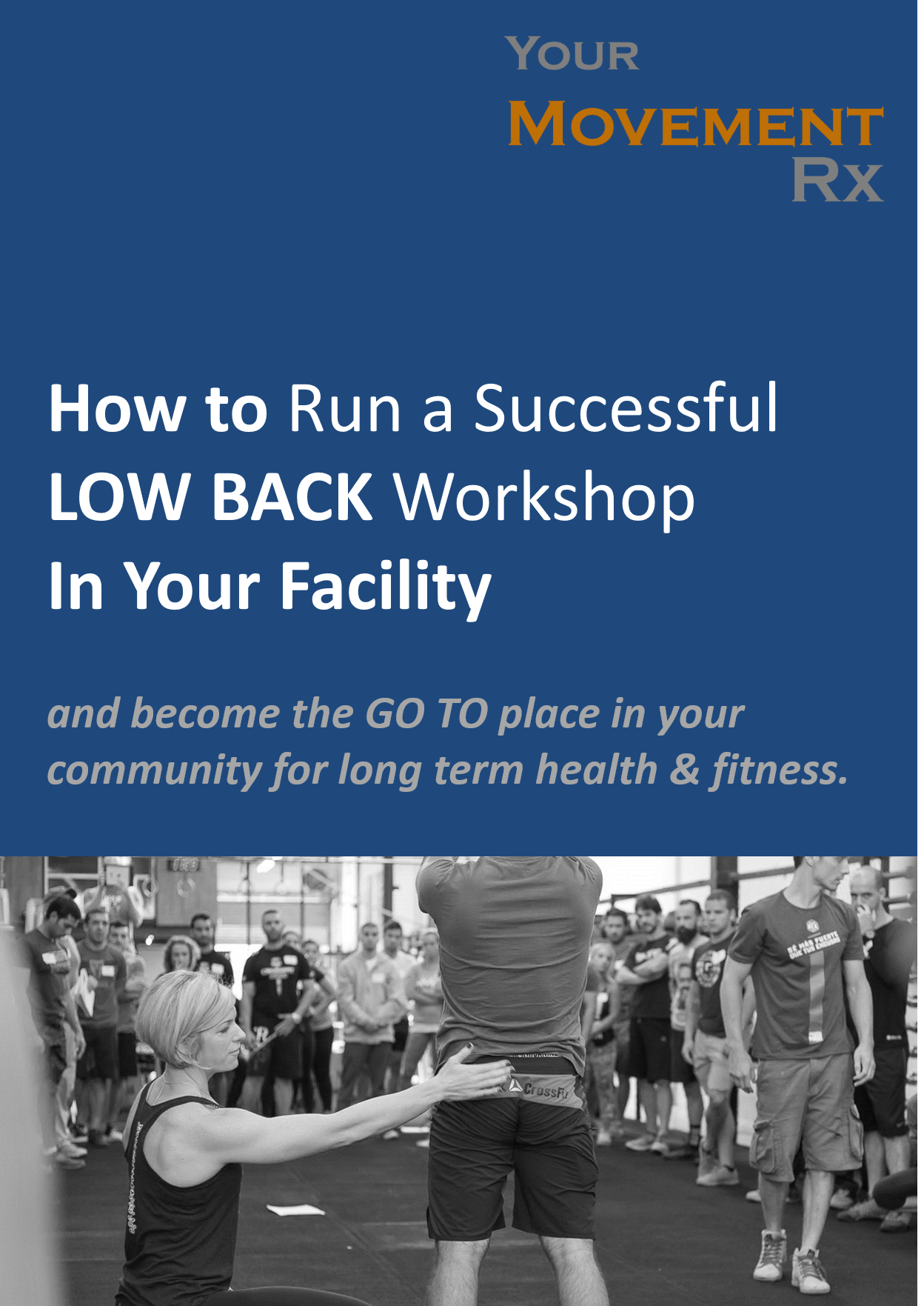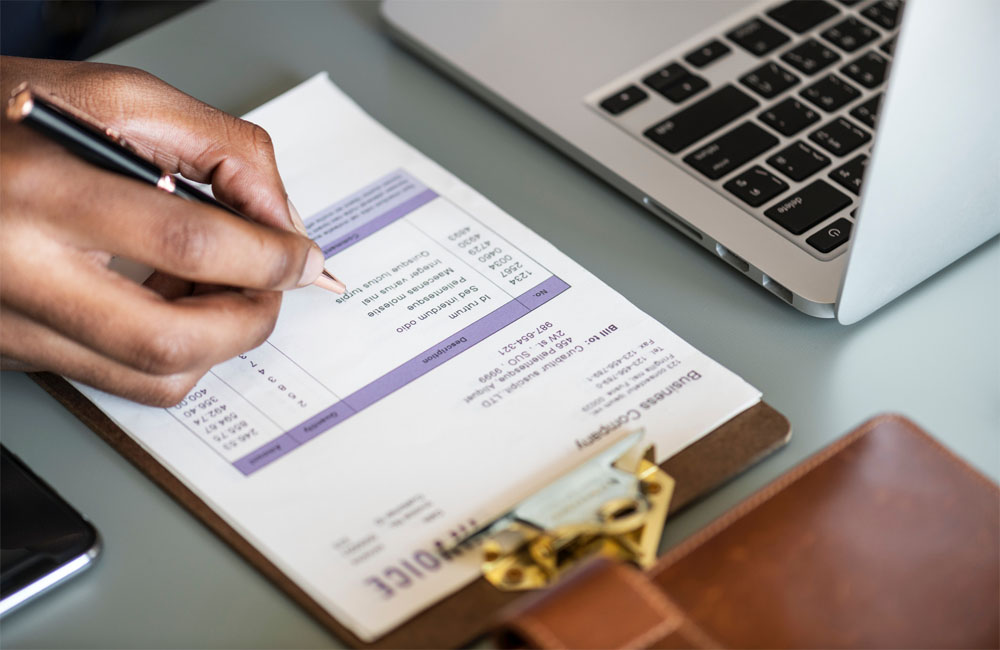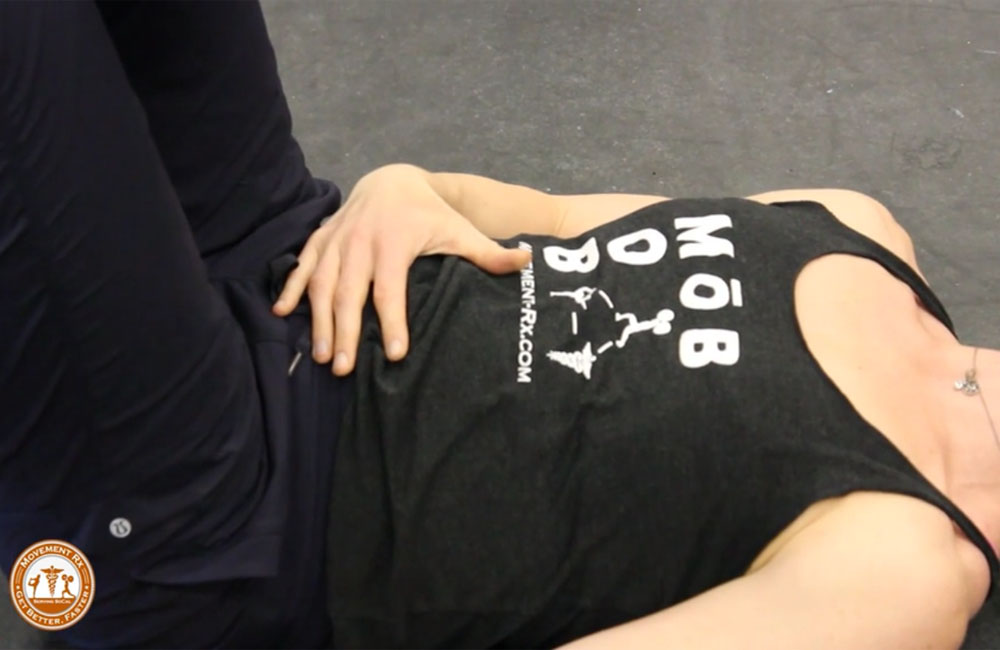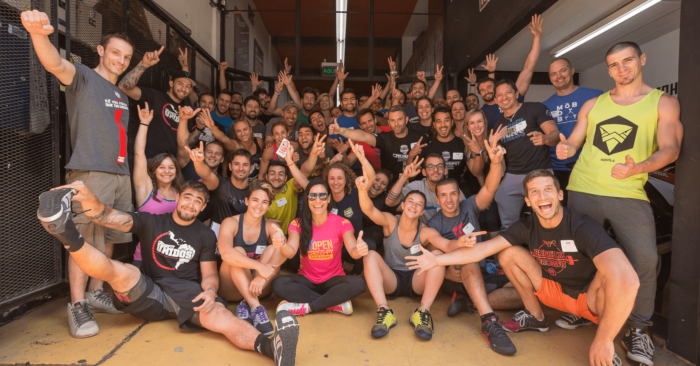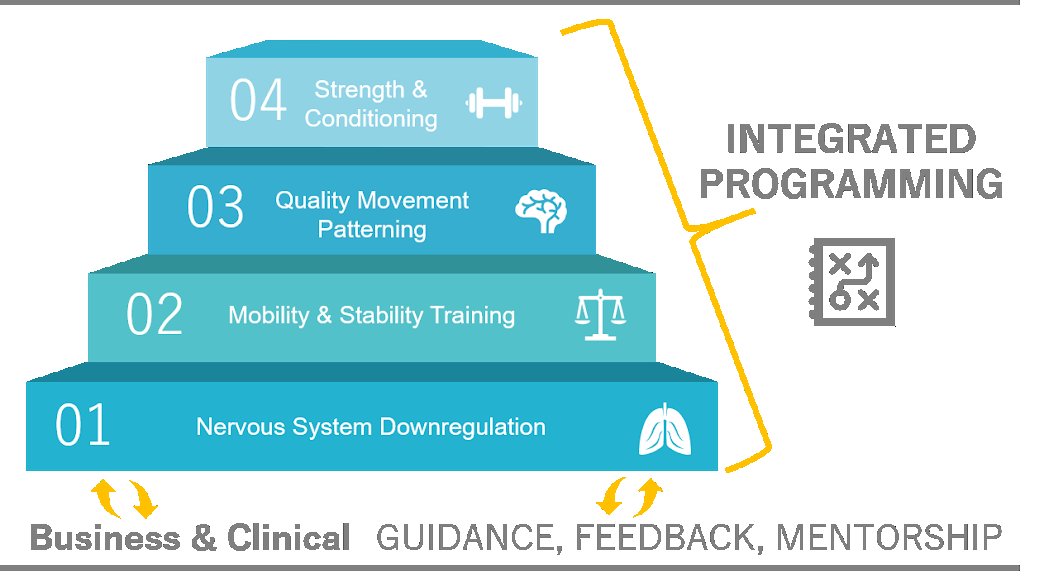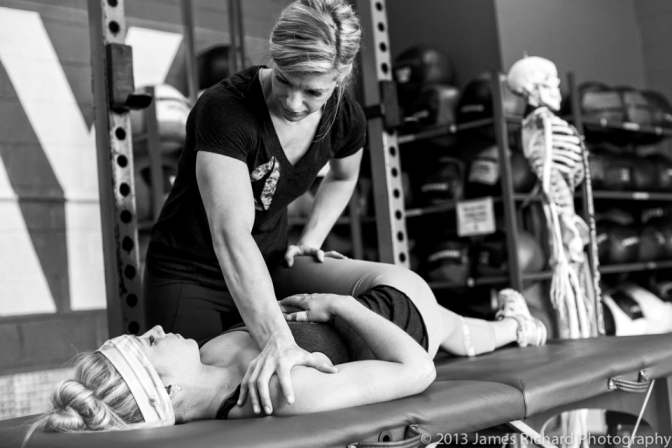Part 1 of this article covered the myths, ROI, and actual causes of back pain. It also introduced a concept called the Pyramid of Physical Freedom and the enormous economic opportunity therein for healthcare and fitness professionals.
Part II provides suggestions on WHAT to do to take advantage of that opportunity and the 5 ways to solve back pain in your community.
If you want to skip the guidance in the article below, begin with this free guide on
Building Your Solution
If you can crack the code to getting clients to the top of the pyramid – regardless of age or interest – chances are you will find ways to solve back pain and become the go-to place in your community for long term health and fitness.
That applies to gym owners, personal trainers, chiropractors, and physical therapists.
So how do you crack the code? How do you become the go-to place for long term health and fitness in your community?
Here’s how we’re accomplishing this at Movement Rx in San Diego. Over time we have built a number of skills and capabilities. We…
- Integrate select down regulation techniques into prehab, rehab, and performance programs.
- Are expert at identifying movement pattern challenges and providing targeted verbal and tactile cues.
- Combine and weight proprietary movement assessments with selected emotional and physical health surveys to identify movement dysfunctions.
- Develop experts at mobility, stability, and motor control coaching.
- Developed a mass-customized repeatable program that integrates all the Tiers of the pyramid; physical therapy techniques, mindset, and strength & conditioning.
- Train Coaches and Doctors of Physical Therapy in our approach and programming.
- Became very good at Digital and Event marketing to build brand, acquire clients, and earn credibility.
- Clearly understand the income statement, balance sheet, and cash flow considerations of our business choices.
- Manage the important economic levers of our businesses, including cost of customer acquisition, lifetime value, churn, and revenue cycle management.
- Know our fixed and variable costs and break-even points.
- Understand pricing levels and our product-market fit.
- Bridge the gap between fitness and healthcare in our market.
Think about which of these your organization does well. We’ll come back to that list later.
If possible, build these capabilities in-house. If that feels like it’s a bit too large of a mountain to climb, the Movement Rx Partner Plus program provides you a short-cut to building them and the expert credibility that comes with these capabilities.
“When it comes to the back most fitness professionals are weary or afraid as it does take specialized training to work with risky back issues. Movement Rx has it down to a science and makes it easy to understand how the back works and reacts to training that is steadily progressive in load, speed and duration.” – H. Loubser, Movement Rx Partner
The 5 Steps to Building Your Solution to Back Pain
Step 1. Commit to Making Your Services Economically Viable
To build a sustainable answer for low back pain in your community, you HAVE to make it economically viable. It makes NO sense to start developing the capabilities without a method to get paid enough to continue to do it.
Understanding the Costs
Let’s use Movement Rx as a case study in what to build as well as the timing and size of major expenses. We have built a very robust solution, so you might scale down to fit your appetite.
- $5,000 per person: Training in the movement, physio, strength & conditioning, and down regulation techniques that make a program actually work, based on just the courses listed in the Training section below. This of course does NOT include the cost of any professional degrees, which aren’t necessary to get started.
- $1,500: Unlimited use of in-depth assessment tools along with training on those assessments.
- $2,500 to $4,000 per month: Hiring a part-time expert in a complementary field to fill out your team capabilities
- $35,000: We spent at least 1,200 hours in drafting, filming, editing, publishing, and integrating the 68 weeks of digital programming we use. This is a mix of hard costs (i.e. actual costs) and a VERY low estimate of soft costs (our time). Your actual hard and soft costs will differ based on your goals, but this is a conservative estimate for an in-depth program.
- $1,500: This is the MINIMUM amount you’ll spend for baseline training in inbound marketing from the likes of ClickFunnels, Digital Marketer, or any other credible source.
- $500-$1,000 per month: This is the amount in digital marketing you should spend to put your training to practice and become a capable marketer.
- $1,000 per month: This is the minimum amount you’d spend for quality business insight from a strategic mastermind group or 1-on-1 business coaching.
- $700 per month: This is the amount we spend on software alone. This includes WordPress plugins, Clickfunnels for sales pages, Mailchimp for email marketing, Zapier for automating connections between our tools, Typeform for surveys, and Pike 13 as a practice management tool.
For the first year, this amounts to roughly $115,000 for a team of 2 people. There are a bunch of other, miscellaneous smaller costs, but the above is a solid representation of what it costs to provide a top notch solution for low back pain in your community. Again, you can of course trim costs by doing less.
Revenue Models
With your cost structure developed, it’s time to figure out your revenue model for back pain services. There are a few standard ones to consider.
- Specialty class programming under current membership. Best for high ticket gyms where specialty programming could improve retention enough to pay for the investment. We suggest starting with a low back workshop.
- Specialty programming under a Membership Plus format. Best for a) gyms looking for ways to increase prices within the next 6-12 months, starting with a membership add-on, and b) no-frills gyms looking for add-on programming options.
- Converting to Membership model: Best for a) physical therapists and chiros looking to extend the patient lifecycle AND build a cash practice or b) personal trainers that want to get away from selling blocks of time.
- 1-on-1 model: Best for personal trainers as well as gyms and chiropractors seeking to optimize revenue generation from existing staff. For perspective, some of our partners have charged as much as $350/hour for 1-on-1 training using our low back program.
Volume is the next variable in the revenue model. Predicting volume can be a total time suck and risky proposition. Risky because you will likely structure your business model on a faulty client volume number. It will be faulty because you don’t have access to the sophisticated modeling tools available required to develop a good estimate. But you need to go through the exercise anyway to highlight the numerous assumptions you need to make in getting to a number. Those assumptions become your management levers as you test client acquisition strategies.
I’ll give you some placeholders to start with based on 6 years of in-person and digital marketing in this realm (plus reviewing thousands and thousands of start-up projections over the last 15 years). These are by no means a given, just educated estimates based on our markets.
- 30% of 11%: Of your current clients, how much would 11% of that total be? That’s statistically how many in a normalized population are experiencing back pain right now. (Chiros and physios will likely have closer to 30% of patients with back pain.) I estimate roughly 30% of this warm audience that believes you are credible will take you up on a quality back-focused service.
- 4% of 11%: This is a number to start with to estimate the amount of people in your broader community that would eventually respond to a quality back-focused service. It will take a few rounds of nurturing to get them there, but for every 10,000 people in a targeted segment, between 40-50 are likely future clients.
You’ve now penciled in first year costs and some revenue model projections. (If you’d like any guidance on this step, schedule a call.) Should you build a solution or buy one?
Buy or Build?
When launching a new line of business, there’s always a buy-vs-build calculus to optimize ROI. Apart from the revenue and cost model, when it comes to solving low back pain, your buy-vs-build decision should be based on the following.
- The business skills of you and your team. Specifically inbound marketing, decision-making, and service.
- The movement coaching skills of your team. Does your team recognize and fix the movement patterns that cause back pain.
- Credibility in your market. Do you honestly have the credibility whereby people in back pain would choose your facility over another one?
- Access to capital. Do you have access to equity or some form of debt?
By the way, if you’re not sure on whether to buy (this includes leasing/subscription) or build, schedule a free advisory call with our team.
Step 2. Fix Clients’ Movement Patterns
The 2nd capability to develop is an expertise in recognizing, cue-ing, and training to fix movement patterns.
Unfortunately this is rare. I’ve interviewed hundreds of physios and chiros and surveyed thousands of our clients. It’s important to understand that the training of physical therapists and chiropractors is incomplete as they earn a degree and licensing in the US. This is perfectly understandable, as there’s only so much that can be covered in a degree program. So physical therapy and chiropractic schools focus curriculum on their healthcare silo. After graduation, the continuing education choices of the practitioner dictate their style of practice. Unless a chiro or physio is uber-motivated to learn unconventional methods and test them on patients, that practitioner significantly limits their ability to heal movement. Again, because movement health comes from multiple healthcare silos.
When it comes to coaches and trainers, most lack a depth of anatomy knowledge and often rely on CrossFit, CSCS, NASM, or ACSM ongoing education to guide them. Most of these are generally insufficient as well.
Assessments
To start down the path of fixing movement patterns, start with an Assessment. Find a method to reliably assess clients so you can track progress and ideally predict injury risk based on how a client performs on the assessment.
- Healthcare practitioners have a variety of assessment tools they may have been trained in, each with pros and cons and tied to a philosophical approach to care.
- The Functional Movement Screen is a go-to for many, as it’s simple to use.
- Or develop your own. We have developed and tested our own proprietary assessments that we use in our clinics that integrate clinical, sports performance, and practical evaluation methods.
The assessment components need to measure the following.
- Emotional energy. Clients’ emotional energy levels over time are a good indicator of their ambient levels of stress. The stress-inflammation pathway is important to manage if the goal is to reduce pain. Part of the overall assessment therefore needs to include a measure of how the client feels about their physical health, mental health, emotional health, and spiritual/fulfillment health.
- Pain. Self-reported pain levels are important to track. While it may seem that this would be the only measure to track, it’s not. Pain is subjective, influenced by the client’s individual endocrine (emotional), and neural (physical and mental) biases. One person’s score of 6 cannot be compared to someone else’s score of 6. The delta, or change, over time is the important measure here.
- Movement Patterns. This is where the real value of a great assessment comes in. Objectively and clearly measuring functional movements is the key to identifying and mitigating risk factors for low back pain. The assessment you use should allow you to easily measure the function of each mobility joint and each stability joint, as well as the regional and global movement patterns those joints are involved in. It should also be simple enough to ensure inter-rater reliability – i.e. one Coach scores clients the same way another Coach does. Finally, the assessment should provide tiers to guide you in the programming you provide the client.
Observing for Quality Movement Patterns
The ability to identify quality movement patterns is a hallmark of a quality coach, trainer, or practitioner. At the level I consider minimum threshold, this capability is unfortunately also rare. Maybe 1 in 10 fitness and health professionals have taken the time in self-study and continuing education to be able to do this effectively. This is not a knock on those 9 in 10 who don’t – this is a relatively new approach. But it is the approach of the future for healthcare and fitness.
The good news for those 9 in 10 is that this doesn’t require some crazy, official curriculum. Such a curriculum does not exist. It takes time, mentors, case studies with experts, and a functional understanding of anatomy, human performance, mobility, stability, balance, and programming.
Become the place for long term health in your community.
Become a Movement Rx Partner.
Programming that blends healthcare and strength & conditioning
You have your assessments in place. You’re developing the ability to observe and correct for quality movement patterns. Now it’s time to provide some structure to enable those skills to benefit your clients.
It’s time to program. Let me make it clear to coaches and trainers that our regular programming is not enough. Let me make it clear to health practitioners that the corrective exercises we provide on paper or even through an app or video platform are definitely not enough. Not even close.
Your programming should seamlessly integrate breath, balance, behavior, correctives, strength, power, and conditioning. The programming should progress in a way that the client is building quality movement patterns while working on the weaknesses uncovered in their assessments.
The upside is that you don’t have to develop this programming yourself. Finding the right one, however, is like choosing the right gym or practice management software. With software, there are too many choices to name, and getting the right one to do exactly what your business needs is mind-numbingly difficult. Just like programming. Of course, we have developed a program at Movement Rx that could be the right one for you. And of course we think it’s the cat’s meow. And it’s available to you through our Partner Plus service. If you’d like to learn about the Partner Plus service, click here, or schedule a call HERE.
Step 3. Reconnect Your Clients’ Brains and Bodies
The third capability to develop is the ability to re-connect your client’s brains and bodies. As mentioned earlier, movement patterns are mostly developed through unintentional repetition of positions. For example, how you sit at your desk all day is a position that will impact your movement patterns. Because most of the positions of back pain sufferers are inactive, tissues shut off much of the day. When it comes time to use them, re-establishing that neural connection between brain and tissue is difficult. This is because neural pathways become dormant or otherwise guarded.
Restoring the activity of these neural pathways takes guided work. We’ve found the most effective restorative combination includes down regulation and well-cued slow strength progressions.
Down Regulation & Neural Tension
The body is laced with nerves that transmit signals to the body. These nerves weave in and out of joints, over muscles, and are in constant communication with the brain. On one end you have the brain and spinal cord sending messages to the body. On the other end are nerve receptors sending messages back to the brain.
Throughout a normal day, your client’s body is under constant stress. Stress is a broad term that explains any stimulus that the body uses energy to combat. There is mental, emotional, and physical stress we all deal with daily. As that stress compounds, the body releases a certain classes of a protein called cytokine into tissues, causing inflammation.
That inflammation wreaks havoc on the nerves that run through the body. With increased inflammation, nerves become vulnerable to compression or elongation. The brain senses this compression as a threat, sends out a pain signal, and the result is chronic lower back pain.
You cannot stretch adverse neural tension. It is deeper than the joints and tissues. The key to eliminating this tension is eliminating stress and inflammation. You can do that through combining breathwork and soft tissue release.
Cues for Smaller Muscle Groups
The second part of reconnecting brain and body works best after down regulation. The art of quality low back strength progressions is in providing cues to activate the smaller, supporting musculature in the glutes, hips, and pelvis prior to activating the larger muscles of the area. To illustrate, for most people, performing a simple 90/90 breath drill with proper muscle activation is difficult. For someone with dormant or guarded neural paths, it’s like learning Greek. But it has to happen. Your cues and progressions are the key to their success.
Step 4. Train Your Staff in Quality Movement and Brain-Body Reconnection
The fourth capability you need to effectively solve low back pain in your facility is a well-trained team. Thankfully there’s no need to put the entire team through continuing education. Just start with a single expert as a go-to resource to help the rest of your team.
“I found that If you have one professional in the team that understands rehab and higher risk mechanics, a quality program…makes it easy to explain to other trainers in the gym to increase their understanding of the back and relevant mechanical influences. So the program can also be used as a teaching tool to your more junior trainers who would like to understand the workings of the body better.” – H. Loubser, Dubai
So how do you train someone to become an expert in your facility? Here is a list of the courses we suggest taking in order to create an appropriate base of knowledge.
- Selective Functional Movement Assessment Levels 1 and 2
- Postural Restoration Institute, Myokinematic Restoration, Pelvis Restoration, Postural Respiration
- MobilityWOD Movement & Mobility 101 & 102 Courses, Functional Training for the Adaptive Athlete
- Clinical Athlete Weightlifting Course
- Power Speed Endurance Art of Breath Course
- Tune Up Fitness Breath and Bliss Course
- CrossFit Weightlifting course with Mike Burgener
The alternatives are to partner with an expert (more on that later) or buy a turnkey solution that already exists. The Movement Rx Partner Plus program includes training, facilitation guides, and over 1,000 videos with cues and points of performance. It also includes access to our team to provide feedback on member movement, plus done-for-you programming your team can follow and learn from.
Starting with that one expert may be what gives your business the opportunity to thrive. It improves retention and creates an asset that can be monetized.
I’ll illustrate using the economics of injuries for a local CrossFit gym here in San Diego.
Case Study: “Hurt Clients Can’t Pay You”
Pain leads to holds, and years of fitness industry research show that holds are far more likely to cancel than active members. This gym has 120 members with an average membership of $140. That’s ~$16,000 in monthly revenues at 12% margins, meaning the gym nets $2,000 each month.
The owner subjectively estimates that half of their 2.5 holds per month and 2 cancellations a month started with pain that led to inactivity.
A quality movement program led by a trained coach with expert cues can easily cut that rate in half, eliminating 1 hold and 1 cancellation a month.
With one less hold and one less cancellation in the first month, that’s $280 in extra revenue. Those two people pay again in month 2, plus another hold is saved and another cancellation is averted. That’s a net gain of $560 in that second month.
The pattern continues such that by month 6 the gym has a net increase in revenue of $1,680 EVERY MONTH and a net increase of 12 members. At these numbers there’s likely little additional expense needed to service those 12 members, leaving most of that extra revenue to flow to the bottom line. The net income has now grown 75% to around $3,500/month.
By developing expertise, that gym has developed a differentiating asset in the community. An entrepreneurial gym owner may choose to monetize that expertise by selling it as specialty programming. As I alluded to earlier, a Movement Rx partner did just this with the Movement Rx low back programming. He turned it into a $350/hour 1-on-1 training program with a dozen participants each month.
The most important impact of a quality pain-focused program? With higher retention rates and possibly more services, the average customer lifetime value increases (LTV). A higher LTV provides you a better return on marketing dollars, allowing you more flexibility in how you promote your business.
Step 5. Find a Partner to Augment Your Capabilities
The 5th step to solving low back pain in your community is to find a partner.
When looking to enter a new line of business or a new market – and becoming the go-to place in the community for low back pain is both – your options are to build the solution, buy the solution, or find a partner.
Let’s handle these one at a time.
Build a solution. We spent thousands of hours building a solution we could use in our clinics, over the internet, and with our corporate well being contracts. Why? Well, there was nothing comparable available to buy, and we believe we have an approach to low back pain that really, really works. If you feel you have the time and spectrum of real expertise, then build. Don’t ignore your opportunity cost, however. (Opportunity cost in this case is the cost to your team of the thousands of hours spent on a new low back offering that aren’t spent on your core business.)
Buy a solution. A solution does exist now – the one we built. However, it’s not for direct sale. We do, however, license it to our Partners. Learn more about that HERE.
Find a partner. To help illustrate this for low back pain, let’s revisit the Pyramid of Physical Freedom with some relevant additions.
Compare your organization to the figure above.
If you candidly assess the capabilities of your team, what is your organization expert at? One of the 4 tiers? The ability and time to develop programming? The operational, financial, and/or marketing chops to develop a new offering in your business? The ability to train your team?
A good partner will complement your capabilities. A great partner will align with your philosophy, your reason for doing what you do…your ‘WHY’.
So how do you pick a partner? For starters, take a look at this simple yet effective set of rules from a successful NYC restauranteur:
You should make sure you have the following:
- Different skill-sets.
- Share the same core values. For example, a few of ours are trust, persistence and treating others well.
- Ability to deeply respect the other person’s skill-set.
- Share the same leadership values and alignment with how you treat people.
- Zero ego from both partners.
- Essentially, make sure you are similar as people and how you lead others, but have skill-sets that are opposites.
If you’re a gym owner or personal trainer, you want a chiro or physio with a mind for business and who really understands the clinical themes covered above.
If you’re a physio or chiro, you want that fitness pro or gym that is committed to quality movement and slowing people down when required.
The end result should be an integration of healthcare, mindset and fitness programming along with a clear method to attract new clients and retain existing ones.
As a final point, remember the old adage: All that glitters ain’t gold. We have put our physical therapy clinics in dozens of gyms over the years. The size and reputation of the gym made very little difference in the quality of integrated care and our bottom line. For our physical therapy clinics, the best clinical and business results have been those gyms where the ownership was totally bought into and respectful of our expertise and the coaches were eager to learn.
So, What’s Next?
If you aren’t interested in a local partner, can’t find a local partner, or feel it’s too big a project to take on, consider Movement Rx as your partner.
Take a look at our Partner Plus program, and feel free to give us a call to discuss.
The Movement Rx Partner Plus program provides our proven movement health programs and marketing tools to become THE place for long term health in your community. The core components include:
- Our Assessments + 5 levels of integrated programming for the low back, shoulder, and knee, accessible anywhere
- Integration of mindset, movement, and strength, a la the Pyramid of Physical Freedom.
- Staff Education, including Monthly How Tos, private fb group, video audits of your clients
- Business Tools and Mentoring, including marketing, finance, & operations.
We look forward to learning more about you!
Schedule an Partnership Advisory Call Here
If you want to start on your own, begin with this free guide on
Latest posts by 5dmin (see all)
- 5 Reasons Why Your Corporate Wellness Program Is Not Working - June 13, 2019
- The Power of Assessments - May 9, 2019
- Healthcare and Fitness Partnerships - April 10, 2019






